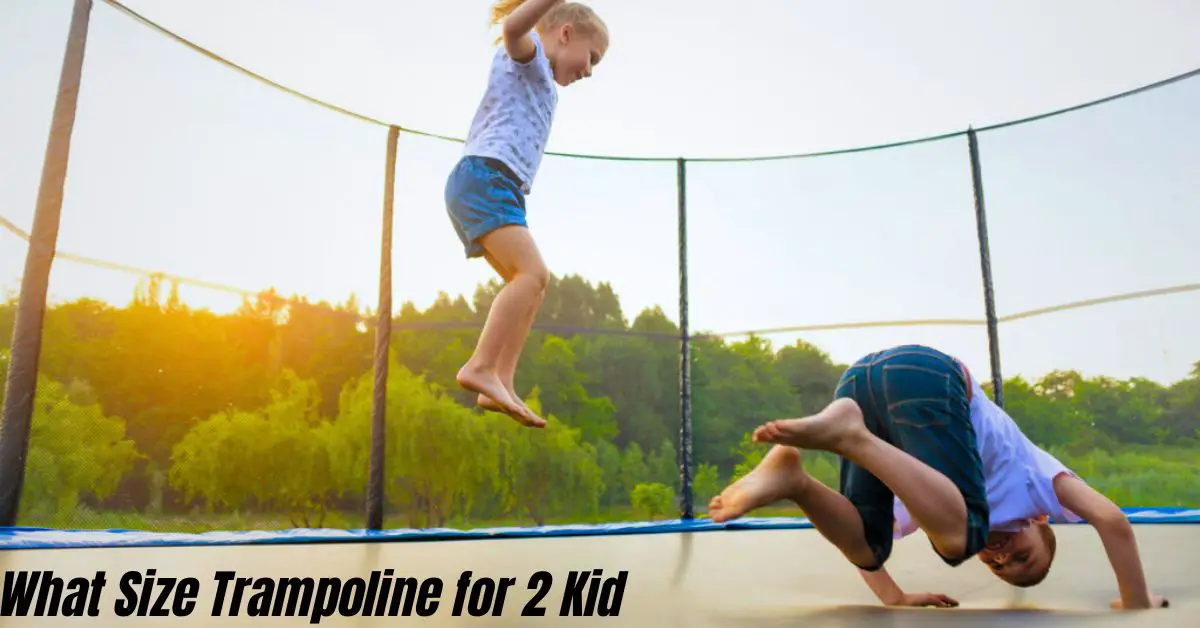When it comes to finding the perfect trampoline size for my family’s love of trampoline sports, I know it’s crucial to make the right choice. Not only will it enhance our jumping experience, but it will also provide maximum entertainment for my children while ensuring their safety.
It can be quite overwhelming to navigate through the various sizes, shapes, and types of trampolines available in the market.
If you are worried about what size trampoline is for 2 kids and what size trampoline is for 3 kids. Trampoline sizes come in a wide range, starting from 36 inches and going up to 17 feet.
However, when I’m looking for the standard trampoline size, I typically focus on options between 8 feet and 15 feet. This range provides a good balance between space and functionality, catering to my family’s needs.
What Size Trampoline for 2 Kids: When choosing a size for 2 kids, consider a medium-sized trampoline (10-12 feet). It provides an ample jumping area and accommodates multiple children, ensuring safe and enjoyable playtime.
What Size Trampoline for 2 Kids?
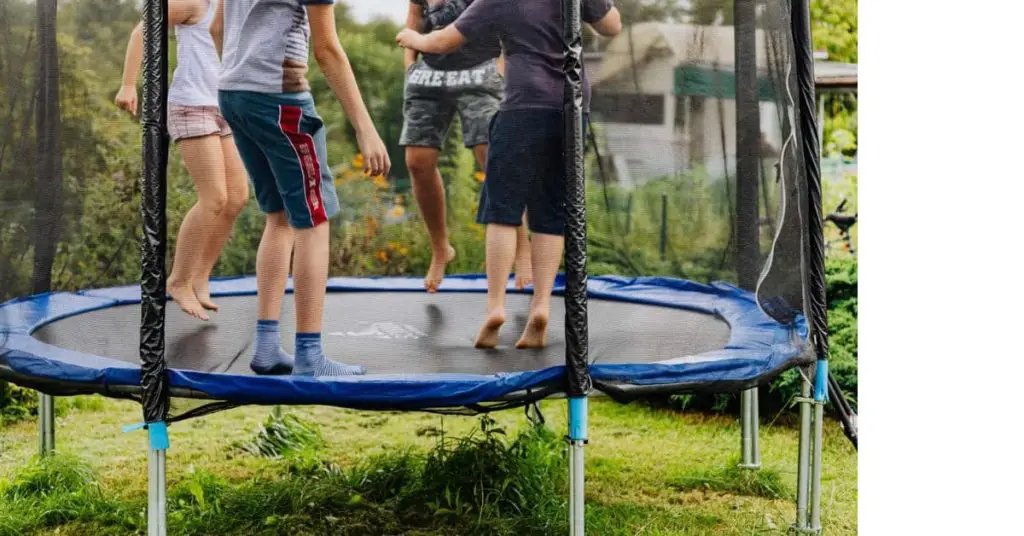
For a trampoline that’s perfect for two kids, an ideal size would be 305 cm (size 10). This size offers enough space for them to jump and have a great time.
However, if you have additional children like cousins or neighbors who would join in the fun and have more space available, opting for a 370 cm model (size 12) would be a fantastic choice.
With the larger size, there’s even more room for everyone to bounce around and enjoy the trampoline together.
Choosing the Right Trampoline Size Based on Your Garden Space
Setting up a trampoline in your garden is not just about having enough space. You need to consider leaving a surrounding area of at least 2 meters, which can extend to 4 meters for larger trampolines. However, if you have limited space, you can opt for a trampoline with a safety net, in which case even a meter of extra space is sufficient.
This recommendation emphasizes the importance of ensuring the safety of trampoline users. Even if you’re not overly protective, the well-being of your children will always be a top priority.
It’s worth noting that mini-trampolines are not suitable for children. They are primarily designed for adults who engage in fitness exercises, as they do not provide the level of protection required for children.
By considering these factors, you can make an informed decision regarding your trampoline’s installation and safety measures, creating a secure and enjoyable environment for your family.
The Importance of Having a Safety Net for Your Trampoline:
The purpose of safety nets is to provide a secure environment for trampoline jumping, preventing users from falling off the jumping mat. However, not all trampolines come equipped with safety nets. So, should you consider getting one?
The primary risk associated with trampoline use is the possibility of falling to the ground. According to a study conducted in Canada, this accounts for approximately a 16% risk of injury requiring a visit to the emergency room and a 47% risk of hospitalization. Due to the relatively higher cost of safety nets, some people choose to forgo them.
However, the decision to have a safety net should not be solely based on economic factors. Instead, it should primarily depend on the size of the trampoline. If you have a large trampoline and your children are over 10 years old and agree to take turns while playing, it might be possible to go without a safety net.
Conversely, if you have a small-sized trampoline, it is strongly recommended to install a safety net.
Considering these factors will help you make an informed decision regarding the necessity of a safety net for your trampoline, ensuring the safety and well-being of those using it.
Choosing the Perfect Location for Setting Up Your Trampoline:
When positioning your trampoline in the garden, it’s important to select the right location. In addition to having enough surrounding space, the ground where you place the trampoline should be level.
You can easily check this by placing a spring in the center of the mat. If it rolls, it indicates that the ground is uneven. In such cases, you’ll need to dig the higher side until the trampoline legs are level. You can verify this again using the spring test.
You should set up your children’s favorite game in a grassy area. While this is a recommendation, it’s best to avoid placing the trampoline on hard surfaces like concrete or a terrace. Additionally, ensure there are no branches near the trampoline and a minimum clearance height of 7 meters above it.
Considering these factors, you can ensure that your trampoline is positioned in the perfect spot, providing your children a safe and enjoyable jumping experience.
Estimated Trampoline Prices Based on Size
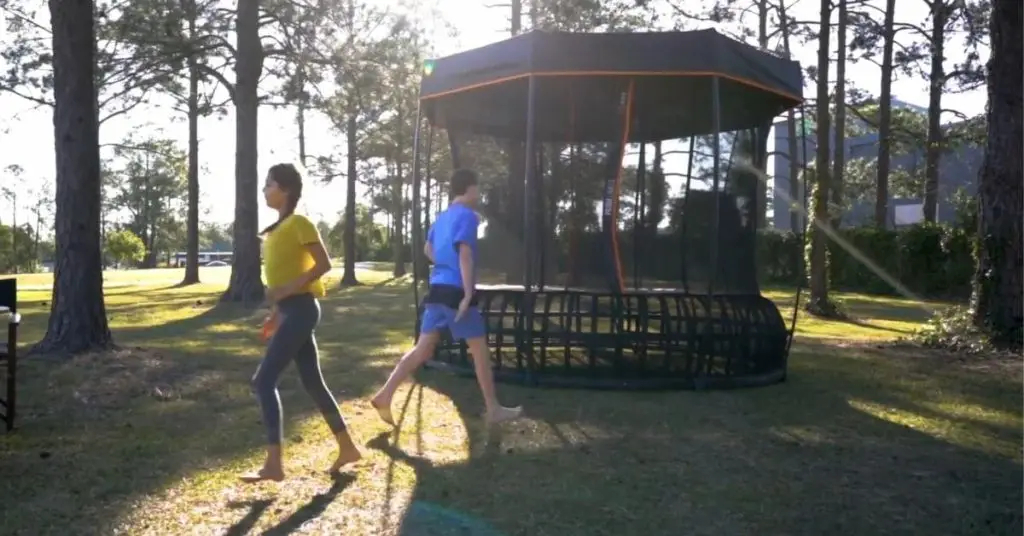
The price of a trampoline can vary depending on its size, specifically the diameter. Here are some estimated price ranges you might find in the market:
- For a trampoline with a diameter of around 1.4 meters, you can expect it to cost just under 100 €.
- For a trampoline with a diameter of approximately 1.8 meters, prices generally range between 100 € and 150 €.
- A trampoline measuring around 2.5 meters in diameter typically falls within the price range of 150 € to 220 €.
- If you’re considering a trampoline with a diameter of about 3 meters, the cost can vary between 200 € and 260 €.
- For larger trampolines around 4 meters in diameter, you can expect prices ranging from 270 € to 320 €.
- Trampolines with a diameter of 4.5 meters or more may cost between 320 € and 440 €.
Additionally, it’s worth noting that the price of a trampoline net is usually around 50% of the total cost.
Will a 15-foot trampoline provide enough space for three kids?
Absolutely! 15-foot trampolines are extremely popular among families and an excellent choice for families with three kids. The spaciousness of a 15-foot trampoline reduces the likelihood of collisions when multiple jumpers are bouncing simultaneously, which is a crucial consideration when purchasing a trampoline.
With a 15-foot trampoline, your kids will have ample room to jump without frequently crossing paths with each other. This ensures a safer and more enjoyable jumping experience for everyone involved.
Will a 14-foot trampoline provide enough space for three kids?
Absolutely! 14-foot trampolines are excellent options for families with three kids. A 14-foot trampoline can accommodate up to five kids playing together when flips are not involved.
For most families with three kids, it provides a sufficiently large space to support their weight as they grow. The 14-foot size ensures enough room for everyone to jump and have a great time, making it an ideal choice for active and playful families.
Will a 12-foot trampoline provide enough space for three kids?
If you have one or two children jumping on the trampoline at a time, a 12-foot trampoline is still spacious enough for three kids. 12-foot trampolines are quite popular among families.
However, to prevent potential conflicts or arguments over trampoline playing time, opting for a 14-foot or 15-foot trampoline is advisable. With a 14-foot trampoline, you’ll typically have enough room for three kids to enjoy their jumping sessions.
If you want to be completely worry-free, a 15-foot trampoline is an excellent choice. It provides even more space, ensuring a comfortable and enjoyable experience for all three kids.
Choosing the Perfect Trampoline Size for Kids
When it comes to trampolines, there are various sizes available to suit different needs. Trampolines under 8 feet are well-suited for younger children to exercise and have fun.
On the other end of the spectrum, trampolines over 15 feet are better suited for larger entertaining spaces. Trampolines with a size of 16 or 17 feet often have a higher weight capacity, making it possible for multiple people to play on them simultaneously.
Now, let’s consider the average trampoline sizes and their target users. The average sizes include 8-foot and 10-foot trampolines, which are perfect for small backyards. A 12-foot trampoline falls into the medium-sized category.
For greater flexibility, 14-foot and 15-foot trampolines are suitable for older users and offer more room for bouncing. Each average-sized trampoline is designed with specific users in mind, such as single children, multiple children, older children, or even adults.
By considering the age, space availability, and intended users, you can select the perfect trampoline size to provide your kids a safe and enjoyable experience.
Trampoline Size for Kids Over 6 Years Old:
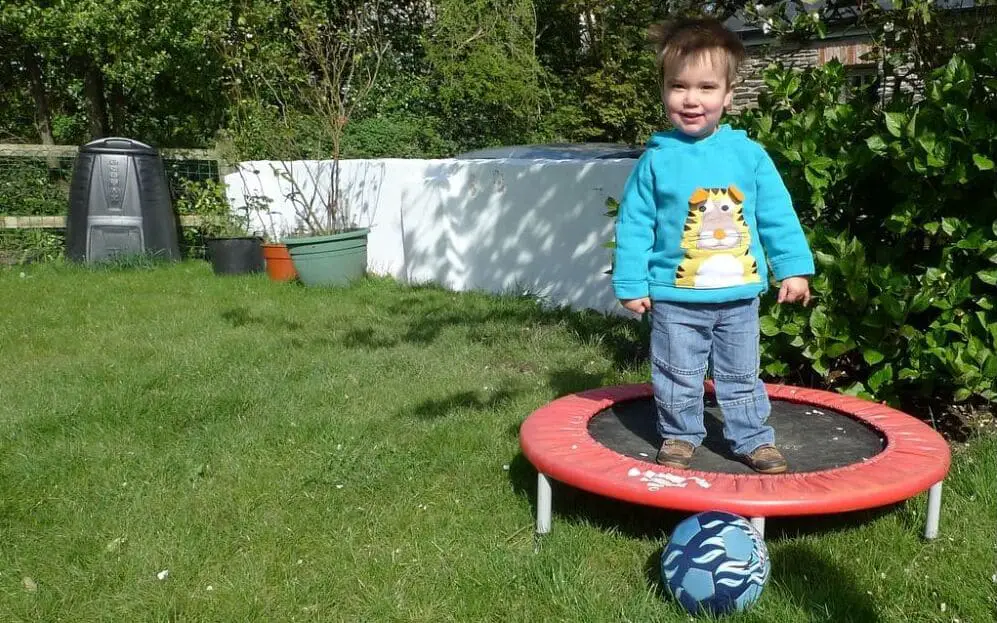
When considering a trampoline for your child, it’s important to consider their future growth. As your child gets older, opting for a larger trampoline size is advisable. While trampolines designed for toddlers are suitable for young children, the 8 to 10-foot trampoline is a great choice for kids aged 6 and above.
This size is also ideal for families with a small backyard and only one child. It offers your child plenty of entertainment and fun over an extended period. However, it’s important to note that there isn’t enough space for a second child to play on an 8 to 10-foot trampoline.
If you’re confident that only one child will use the trampoline at a time, this size is perfect for you.
Size for Larger Families or Older Children:
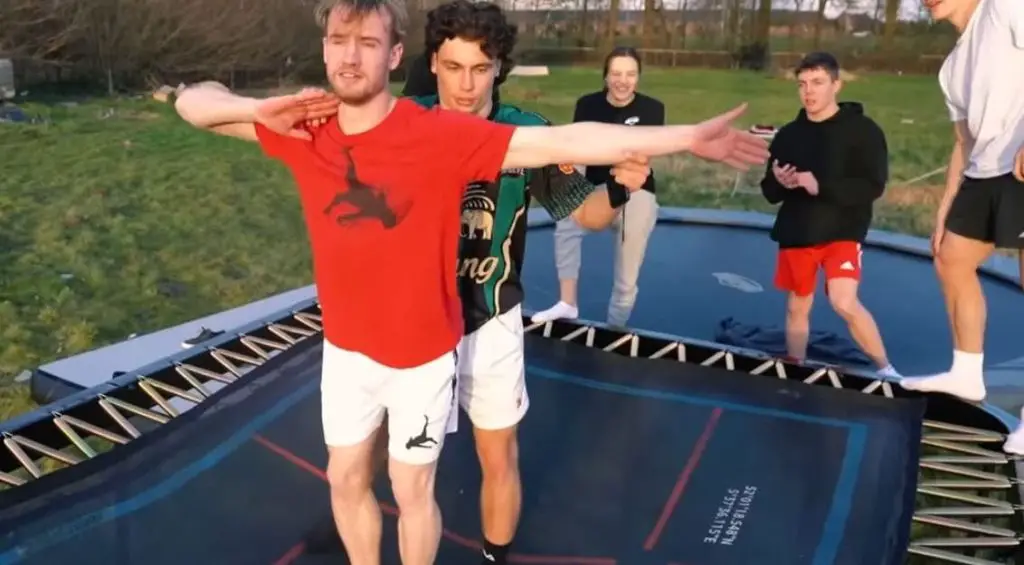
The 14 to 15-foot trampoline is a fantastic option if you have a spacious backyard and multiple children who want to play together. It’s a full-size trampoline with ample room for three or four kids to enjoy jumping simultaneously. This trampoline provides a large jumping surface and a ladder for easy access and safe play.
With more springs and a heavier construction compared to medium or small-sized trampolines, children will have an even better bouncing experience. If you want to create a fun and engaging environment for your kids, the 14 to 15-foot trampoline is the perfect choice.
Ideal Trampoline Size for Kids Under 5:
Trampolines designed for children under 5 years old are specifically made in smaller sizes by manufacturers. These trampolines have a lower weight capacity, typically ranging from 100 to 140 pounds or sometimes up to 150 pounds.
Since toddlers have less weight, they can safely enjoy playing on these trampolines. You can find trampolines for toddlers in various sizes, such as 36, 38, 40, 48, 55, and 66 inches.
These smaller trampolines are specifically designed for toddlers, infants, and children aged 2 to 5. They provide a safe and enjoyable bouncing experience for our little ones.
Perfect Trampoline Size for Two Children:
The 12-foot trampoline is a great choice if you have two children and a medium-sized backyard. It offers the perfect size for kids to have fun and play together. This medium trampoline provides ample space for jumping and bouncing without taking up as much room as a larger 14 to 15-foot trampoline.
While it requires slightly more space than a smaller trampoline, it is worth considering. The 12-foot trampoline is an ideal fit for a medium-sized backyard and within a reasonable budget range. Invest in this size, and you’ll create a wonderful play area for your kids while maximizing available space.
Ensuring Satisfaction with Your Trampoline Purchase:
When purchasing a trampoline for multiple children to jump on together, choosing one that can withstand their combined weight is important. You also want to consider a trampoline that will accommodate your child’s growing weight over time.
For kids, I recommend the “12 FT Outdoor Trampoline With Enclosure” from Zupapa. This trampoline is equipped with more springs, providing enhanced bounce and ensuring your child has a blast while jumping. Zupapa’s “Small Trampoline for Kids” is an excellent option if you have younger children.
It offers a size more suitable for younger kids. It includes an enclosure net directly attached to the jumping mat, eliminating any dangerous gaps and creating a safe and fun environment.
By selecting the right trampoline size and model, like those from Zupapa, you can ensure that your family is satisfied with your purchase and enjoy many years of fun on the trampoline.
Helpful Tips for Selecting a Trampoline for Three Kids
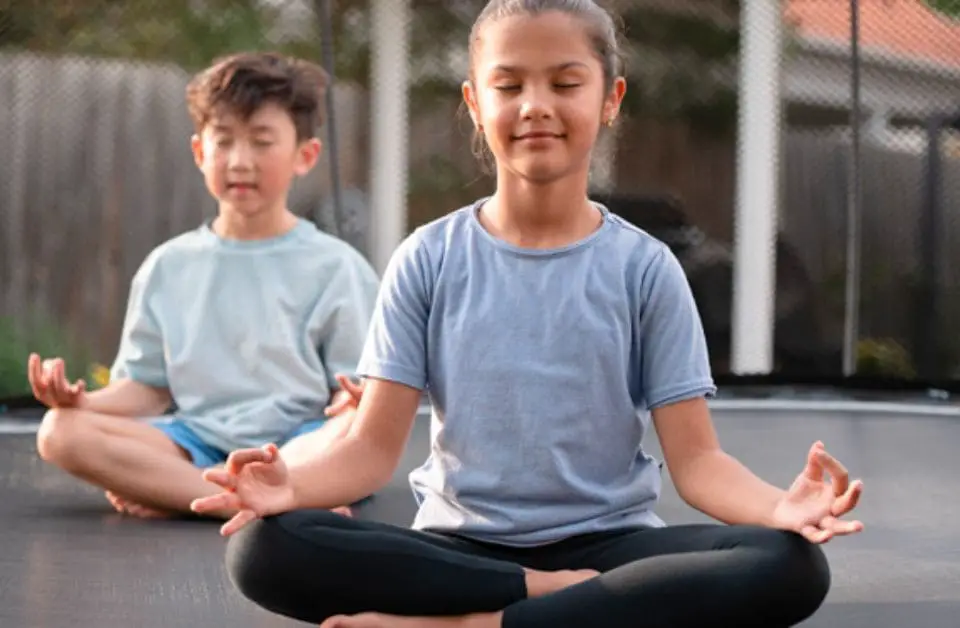
Here are some tips for selecting a trampoline for three kids:
- Opt for a Larger Size: When in doubt, go for the largest trampoline size available, typically around 15 or 16 feet. More space to jump will ensure a better experience for all three kids.
- Prioritize Safety: Invest in a trampoline with a safety enclosure. This is especially important when multiple kids are jumping together. The enclosure prevents them from falling off the trampoline or colliding with the frame.
- Consider Round Trampolines: Round trampolines are generally better suited for family use. However, if you want a trampoline for gymnastics practice, you can choose a square-shaped one.
- Supervision for Young Kids: Children below 6 years old should be closely supervised when using a trampoline. It’s important to ensure their safety and well-being during jumping sessions.
- Mini Indoor Trampolines for Toddlers: If you have toddlers, it’s recommended to consider mini indoor trampolines designed specifically for their age group. These trampolines provide a safe and fun jumping experience for younger children.
By following these tips, you can make an informed decision when choosing a trampoline that will accommodate all three of your kids and prioritize their safety.
Factors to Consider when Selecting a Trampoline Size
Here are some factors to consider when selecting a trampoline size:
Available Space:
Measure the area where you plan to install the trampoline to ensure it can accommodate the chosen size. Consider both the diameter/length and the height clearance needed for safe jumping.
Number of Users:
Determine how many people will be using the trampoline at the same time. If it’s primarily for one child, a smaller size might suffice. For multiple users, especially if they’re older or larger, a larger trampoline will provide more space for everyone to jump comfortably.
Age and Size of Users:
Consider the age and size of the intended users. Smaller children may feel more comfortable on a smaller trampoline, while older kids or adults may prefer a larger size for a better jumping experience.
Safety Considerations:
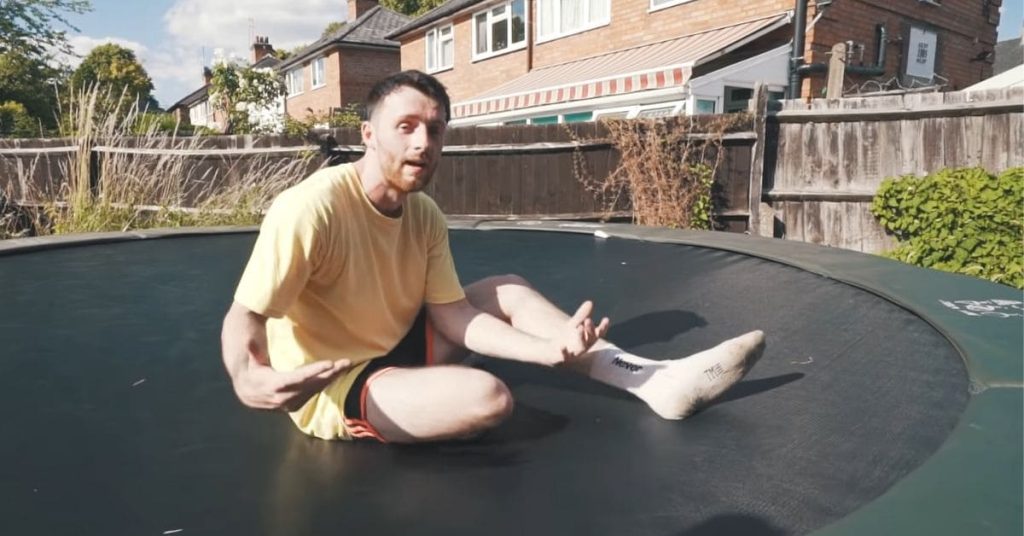
Ensure that the trampoline size allows sufficient clearance from any surrounding objects like walls, trees, or furniture. Also, consider the trampoline’s weight capacity to ensure it can safely accommodate the intended users.
Budget:
Consider your budget when selecting a trampoline size. Larger trampolines tend to be more expensive, so determine the maximum size that fits your budget without compromising safety and quality.
By considering these factors, you can choose a trampoline size that suits your available space, the number and age of users, and your budget, ensuring a safe and enjoyable jumping experience for everyone.
Safety Precautions and Guidelines
Here some safety precautions and guidelines:
Installing Safety Enclosures:
- Ensure that a safety enclosure or netting is properly installed around the trampoline to prevent users from falling off.
- Check that the enclosure is securely attached and free from any tears or gaps that could pose a safety hazard.
- Regularly inspect the safety enclosure for any signs of wear and tear, and replace or repair it as needed.
Regular Maintenance and Inspections:
- Conduct routine inspections of the trampoline’s frame, springs, and mat for any damage or signs of wear.
- Replace any worn-out or damaged parts promptly to maintain the trampoline’s safety and functionality.
- Keep the trampoline clean and free from debris to prevent slips and accidents.
Setting Rules for Safe Trampoline Use:
- Establish clear and age-appropriate rules for trampoline usage, and ensure that all users are aware of and follow these rules.
- Limit the number of jumpers on the trampoline to reduce the risk of collisions.
- Prohibit somersaults and other high-risk maneuvers unless supervised by a trained professional.
- Encourage safe jumping techniques, such as keeping both feet on the mat and avoiding jumping off the trampoline.
Remember, while following safety precautions and guidelines can minimize the risk of injuries, adult supervision, and caution are crucial to ensuring a safe trampoline experience for everyone involved.
Budget Considerations
Here are some additional budget considerations:
Determine your Budget Range:
Before purchasing a trampoline, establish a budget that aligns with your financial capabilities. Consider how much you will spend on the initial purchase and any additional expenses, such as accessories or maintenance costs.
Research Prices:
Compare prices from different retailers and brands to understand the cost range for trampolines of the desired size and quality. Remember that higher-quality trampolines might come with a higher price tag but can offer better durability and safety features.
Consider Long-Term Investment:
While it may be tempting to opt for a cheaper trampoline, consider the long-term value and durability of the product. Investing in a higher-quality trampoline that will last longer and require fewer repairs or replacements may save you money in the long run.
Evaluate Additional Costs:
Consider any additional expenses associated with the trampoline, such as safety enclosures, ladders, anchor kits, or protective covers. These accessories can contribute to the overall cost but may be necessary for ensuring the safety and longevity of the trampoline.
Look for Sales and Discounts:
Keep an eye out for seasonal sales, promotions, or discounts retailers offer. This can help you find a trampoline that meets your budget requirements while still meeting your desired specifications.
Remember, while it’s important to consider your budget, prioritize safety and quality when choosing a trampoline for your family. Opting for a reliable and well-constructed trampoline may provide greater peace of mind and ensure a safer and more enjoyable experience for everyone.
FAQs:
Q:1 What size trampoline is suitable for two kids?
A trampoline size of 12 to 14 feet is generally recommended for two kids. This provides enough space for them to jump and play comfortably without colliding with each other.
Q:2 Can two kids jump safely on a smaller trampoline, such as an 8-foot or 10-foot?
While it is possible for two kids to jump on a smaller trampoline, such as an 8-foot or 10-foot, it may increase the risk of collisions. It is generally safer to opt for a larger trampoline to ensure adequate space for both kids.
Q:3 Is it necessary to consider the weight limit of the trampoline?
Yes, it is crucial to consider the weight limit of the trampoline. Ensure the weight limit accommodates the combined weight of both kids to ensure safe usage.
Q:4 Are rectangular or round trampolines better for two kids?
Both rectangular and round trampolines can work well for two kids. Round trampolines typically provide a larger jumping area, while rectangular trampolines offer a more consistent bounce. Choose the shape based on your personal preference and available space.
Q:5 Can older and younger kids jump together on the same trampoline?
It is generally safe for older and younger kids to jump together on the same trampoline, but adult supervision is highly recommended. Ensure that the trampoline size and weight limit can accommodate both age groups.
Q:6 Should I consider a trampoline with a safety enclosure for two kids?
Yes, a safety enclosure is highly recommended for trampolines used by two kids. It helps prevent accidental falls off the trampoline and adds an extra layer of safety.
Q:7 What factors should I consider besides the trampoline size?
Along with trampoline size, consider factors such as weight limit, safety features (padding, enclosure), durability, and quality of construction. These elements contribute to a safer and more enjoyable trampoline experience for two kids.
Conclusion:
In conclusion, when choosing a trampoline size for two kids, opting for a 12 to 14-foot trampoline is recommended. This provides enough space for them to jump and play without colliding. While smaller trampolines can be used, they may increase the risk of collisions.
It’s important to consider the trampoline’s weight limit to ensure it can safely accommodate both kids. Additionally, considering factors such as shape, safety enclosure, and overall quality will contribute to a safer and more enjoyable trampoline experience.
Always prioritize safety, supervise their playtime, and follow the manufacturer’s guidelines for a fun and safe trampolining experience for your children.
After reading this comprehensive article, we hope you will be well aware of what size trampoline is for 2 kids and what size trampoline is for 3 kids. If you have any questions, feel free to comment below!

